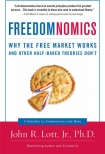Freedomnomics: Why the Free Market Works and Other Half-Baked Theories Don't John Jr. (the dot read aloud .txt) 📖

- Author: John Jr.
Book online «Freedomnomics: Why the Free Market Works and Other Half-Baked Theories Don't John Jr. (the dot read aloud .txt) 📖». Author John Jr.
Toward the beginning of my academic career, when I was briefly affiliated with Montana State University in Bozeman, I saw firsthand the conflict of interest between academics’ private interests and the best public policy. My wife—also a new Ph.D. in economics—and I had managed to find jobs in the same place. Soon after we moved to Bozeman in May 1986, Constitutional Initiative 27, which would have abolished property taxes in Montana, was put on the ballot. The vote was set for November, but the measure immediately elicited all kinds of horror stories in the press claiming that, if approved, the initiative would virtually eliminate Montana’s state and local government. The state superintendent of public schools warned that it would force the closure of all the state’s elementary schools. The governor and other top state officials resorted to similar jeremiads, releasing reams of statistics and twisting the data to support totally false claims such as the contention that Montana already was the lowest taxed state in the nation. In light of the barrage of criticism, most people, including myself, assumed the initiative would go nowhere.
But the facts were quite different from the fantastic declarations of public officials. The elimination of the property tax in 1984 would have left state and local government treasuries with at least $2 billion to spend—23.7 percent of personal income in the state. Thirty-five other states did quite well spending even less than that ratio. In fact, the state would have been left with even more money than that since income tax revenues would have risen when people and corporations lost their property tax deductions.
I could see that the statistics being bandied about in the press were misleading, but no one was challenging them. Initially, I decided to get involved only by writing an op-ed piece, which appeared on July 13, 1986, in the Great Falls Tribune and The Montana Standard (Butte). Until then, I hadn’t had any contact with the four sisters who were primarily responsible for putting the initiative on the ballot. But after one of them, Naomi Powell, contacted me, I agreed to get more involved.
I went to Helena to talk to Frank Adams, a former newspaperman who was writing the ballot statement for the initiative. Then I met with the four sisters and some of their supporters in the small western Montana town of Corvallis. I quickly realized part of the reason why the initiative was having so many problems: the press was relentlessly attacking the sisters as “John Birchers” and as members of other sinister groups. Reporters were also angered by the sisters’ inability to answer immediately some of their more complex economic questions—the sisters often had to delay their replies until they could do some more research.
Having retired with their husbands to the Bitterroot Valley, the sisters ranged in age from their late fifties to late sixties. Living on fixed incomes, they had felt the squeeze as the cost of living, especially their property taxes, had risen. The sisters were hardly wealthy—the furniture in Naomi’s well-kept house was old and worn, and the windows had cracks that were mended with tape. They had spent much of their life savings trying to get the initiative on the ballot, traveling around the state and bedding down in sleeping bags while collecting signatures. The initiative, while not perfect, was pretty good—the effort struck me as an example of everyday Americans identifying a problem and trying to solve it. Collecting 50,000 signatures was not a problem. Ensuring the initiative received a fair hearing, however, was another story.
In hindsight, it was really the unfairness of the campaign against the initiative that prompted me to get more deeply involved in the effort. The fact that Naomi had my op-ed piece taped to her refrigerator door and told me, with tears in her eyes, that she would read it whenever people attacked her group or when they ran into other difficulties, probably didn’t hurt either.
Initially, I agreed to handle “number-type questions” from the media. But I quickly found that all press inquiries were being routed in my direction, and that I had become the unofficial (and later official) spokesman for the initiative. I viewed my primary role as just getting the correct numbers out to the press, although I ended up talking to some legislators and other individuals about the benefits of lower taxes. By early August, I had become a regular on the state-wide Montana Television News Network.
Newspaper editorials began attacking my involvement as soon as my op-ed first appeared. By late August, I learned that the Commissioner of Political Practices had come close to filing felony charges against me for ostensibly violating a law forbidding state employees from engaging in political campaigns. I had no idea that such a law even existed, but fortunately for me, I wasn’t on a state salary at the time because I was scheduled to go on leave at the Hoover Institution at Stanford University the following academic year. Learning of this, the commissioner’s office dropped its investigation of me. Curiously, no one threatened to prosecute the host of state-salaried academics and other state employees who were energetically campaigning against the initiative.
During August, I also began hearing complaints about my activities from the Montana State University administration. The chairman of my department repeatedly told me that the dean didn’t want me to continue publicly advocating the initiative. But I continued my work anyway, helping Frank Adams, who had also become an official spokesman for the initiative, send out a flurry of press releases. Before I left for Hoover, I helped to convince several





Comments (0)